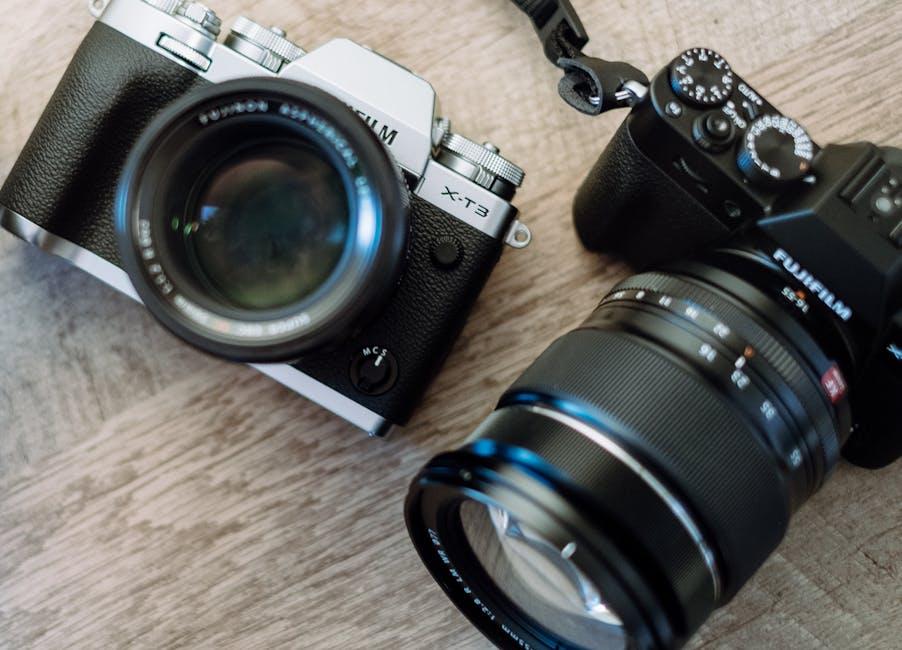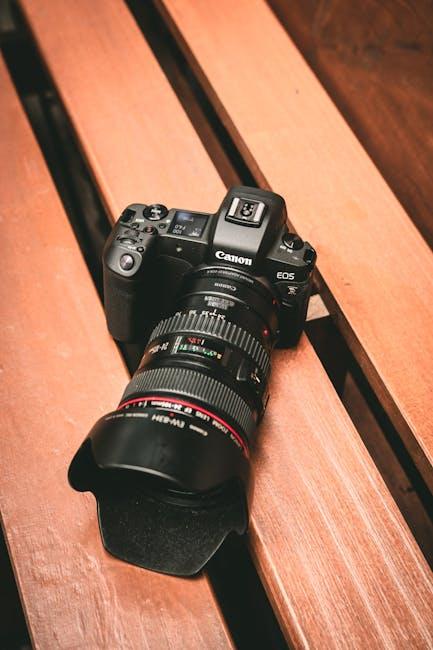
In a world where every fleeting moment can be immortalized wiht the click of a button, photography has undergone a profound transformation. “Capturing the Future: PhotographyS Digital Evolution” delves into the journey from film grains to pixel-perfect images, exploring how digital technology has reshaped not only the tools and techniques of photographers but also the very essence of visual storytelling. This evolution has democratized the art form, enabling enthusiasts and professionals alike to experiment and innovate in unprecedented ways. As we navigate through advancements in camera technology, software enhancements, and the rise of smartphone photography, this exploration seeks to understand how digital progress continues to redefine our ability to capture and share the world around us.
Table of Contents
- advancements in Sensor Technology Enhancing Image Quality
- the Role of artificial Intelligence in Modern Photography
- Embracing Mirrorless Systems for Versatile Shooting
- Cloud Integration: Streamlining Storage and Collaboration
- Innovations in Computational Photography Shaping Future Techniques
- Sustainable practices in Digital Photography Evolution
- In Conclusion

Advancements in Sensor Technology Enhancing Image Quality
The heart of every digital photograph lies in its sensor, and recent advancements in sensor technology have revolutionized image quality in ways previously unimaginable. Modern sensors boast higher megapixel counts without sacrificing low-light performance, thanks to innovations like backside-illuminated (BSI) designs. This architecture allows more light to reach each pixel,resulting in sharper images with greater detail and reduced noise,even in challenging lighting conditions.
Another groundbreaking development is the integration of stacked sensor designs, which separate the photodiode layer from the circuitry layer. This separation enables faster data processing and increased readout speeds, leading to improved dynamic range and superior color accuracy. Additionally, global shutter technology has made its way into consumer cameras, eliminating the rolling shutter effect and ensuring that fast-moving subjects are captured with crystal clarity and minimal distortion.
emerging technologies such as quantum dot sensors and computational imaging are also pushing the boundaries of what’s possible. Quantum dot sensors enhance light sensitivity and color reproduction, while computational imaging leverages powerful processors to combine multiple exposures, resulting in images that are both vibrant and true to life.These innovations collectively ensure that photographers have the tools to capture the finest details and the richest colors, paving the way for the future of digital photography.
| Sensor Technology | Key Benefits | Impact on Image Quality |
|———————–|—————————————–|———————————–|
| Backside-Illuminated | Enhanced low-light performance | Sharper images with less noise |
| Stacked Sensors | Faster data processing and readout | Improved dynamic range and color |
| Global Shutter | Eliminates rolling shutter distortions | Clear capture of fast-moving subjects |
| Quantum Dot Sensors | Increased light sensitivity and color | Vibrant, true-to-life colors |
These sensor advancements are not merely incremental improvements but represent a significant leap forward in the pursuit of photographic excellence. As technology continues to evolve, the synergy between hardware innovations and software enhancements promises even greater achievements in image quality, empowering photographers to bring their creative visions to life with unprecedented fidelity.
The Role of Artificial Intelligence in Modern Photography
Artificial Intelligence (AI) has seamlessly woven itself into the fabric of modern photography, transforming not just how images are captured but also how they are processed and experienced. From enhancing image quality in real-time to enabling features like facial recognition and scene optimization,AI empowers photographers—both amateur and professional—to achieve results that were once thought unfeasible. by leveraging machine learning algorithms, cameras can now anticipate the perfect moment to capture, adjust settings dynamically, and even suggest creative compositions, thus democratizing high-level photography skills.
One of the most significant advancements AI brings to photography is its ability to automate post-processing tasks.Traditional editing can be time-consuming and requires a keen eye for detail, but AI-driven tools can analyze images and apply adjustments with remarkable precision and speed. This not only streamlines workflows but also ensures consistency across large batches of photos. Additionally, AI facilitates innovative features such as upscaling resolution without loss of quality, reducing noise in low-light conditions, and even transforming photos into various artistic styles, providing endless creative possibilities for photographers.
Moreover, AI-enhanced photography is redefining the boundaries of storytelling. Bright algorithms can detect and highlight key elements within a scene, enabling photographers to craft narratives that resonate more deeply with their audience. Features like automated tagging and categorization also make organizing and retrieving photos more intuitive, allowing creatives to focus more on their vision rather than the logistics of managing their collections. As AI continues to evolve, its integration into photography promises to unlock new horizons, making the art more accessible, efficient, and innovative than ever before.
| AI Feature | Impact on Photography |
|—————————|———————————-|
| Real-time image Enhancement | Superior image quality on the fly |
| Automated Editing | Saves time and ensures consistency |
| Scene Recognition | Optimizes settings for various environments |
| Creative Composition Tools | Inspires innovative photographic techniques |
Embracing Mirrorless Systems for Versatile Shooting
As photography strides into its digital future, mirrorless systems have emerged as the vanguard of innovation. Unlike traditional DSLRs, mirrorless cameras eliminate the bulky mirror mechanism, resulting in more compact and lightweight designs. This shift not only enhances portability but also opens the door to unprecedented adaptability and creative freedom for photographers of all levels.
Mirrorless systems excel in versatile shooting scenarios, seamlessly adapting to both still photography and videography. Their electronic viewfinders provide real-time previews, allowing for precise adjustments on the fly. Additionally, the rapid advancements in autofocus technology ensure sharp, dynamic captures, whether you’re shooting fast-paced street scenes or intricate portraits.The integration of interchangeable lenses further amplifies their adaptability, catering to a wide range of artistic visions.| Feature | Mirrorless Cameras | DSLR Cameras |
|———————–|————————-|———————–|
| Size & Weight | Compact and Lightweight | Bulkier and Heavier |
| autofocus Speed | Fast, with Advanced AI | Reliable but Slower |
| Video Capabilities| Superior 4K & Beyond | Limited 4K Options |
| Viewfinder | Electronic, Real-Time | Optical, Through Mirror|
| Battery Life | Moderate | Extended |
Embracing mirrorless technology means stepping into a realm where versatility meets cutting-edge performance. Whether you’re a seasoned professional or an keen hobbyist, mirrorless systems offer the tools to capture the world with clarity and creativity. As the digital landscape continues to evolve, adopting mirrorless cameras ensures that your photography remains at the forefront of innovation, ready to capture the future in every frame.
cloud Integration: Streamlining Storage and Collaboration
In the ever-evolving landscape of digital photography, cloud integration has emerged as a pivotal force in transforming how photographers store, manage, and collaborate on their work. By leveraging the power of the cloud, photographers can effortlessly access their vast libraries from anywhere in the world, ensuring that their creative assets are always at their fingertips. This seamless accessibility not only enhances workflow efficiency but also provides a safety net against data loss, safeguarding precious memories and professional projects alike.
Collaboration has never been easier thanks to cloud-based platforms. Teams of photographers, editors, and clients can work together in real-time, sharing feedback and making adjustments without the constraints of geographical boundaries.This level of connectivity fosters a more dynamic and interactive creative process, allowing for quicker turnarounds and a more cohesive final product. additionally, cloud integration supports scalable storage solutions, accommodating the growing demands of high-resolution images and extensive project archives without the need for costly physical infrastructure.
| benefit | Description |
|———————–|————————————————————|
| Accessibility | Access files from any device, anywhere, anytime. |
| Collaboration | Real-time teamwork with instant sharing and feedback. |
| Scalability | Easily expand storage capacity as your portfolio grows. |
| Security | Advanced encryption and backup systems protect your data. |
Embracing cloud integration is not just a trend but a strategic move towards future-proofing photography businesses and enthusiasts alike. As the digital realm continues to expand, those who harness the full potential of the cloud will find themselves better equipped to navigate the challenges and seize the opportunities that lie ahead in the dynamic world of photography.
Innovations in Computational Photography Shaping Future Techniques
Computational photography has revolutionized the way we capture and perceive images,blending traditional photography with advanced algorithms to push the boundaries of what’s possible. One of the most significant innovations is the integration of artificial intelligence, which enables cameras to recognize scenes, adjust settings in real-time, and enhance image quality beyond the limitations of hardware alone. This synergy between hardware and software allows photographers to achieve professional-grade results with consumer-grade equipment, democratizing high-quality image creation.
Another groundbreaking advancement is light field technology, which captures facts about the light rays in a scene, including their direction and intensity. This enables features like post-capture focus adjustment and 3D rendering, giving photographers unparalleled flexibility and creative control. Additionally, computational zoom leverages image stitching and enhancement algorithms to provide high-resolution zoom capabilities without the need for bulky optical components, making powerful zoom functionalities more accessible in portable devices.
The rise of multi-frame and burst photography techniques also plays a crucial role in enhancing image quality.By capturing multiple frames in rapid succession and intelligently merging them, these techniques reduce noise, improve dynamic range, and create stunning HDR images. Furthermore, advancements in augmented reality (AR) and virtual reality (VR) integration are opening new avenues for immersive photography experiences, where viewers can interact with and explore images in three dimensions.
| Innovation | Description | Application |
|————————-|——————————————————-|——————————–|
| Artificial Intelligence | Scene recognition and real-time adjustments | Automated settings, enhanced editing |
| light Field Technology | Captures light direction and intensity | Post-capture focus, 3D rendering |
| Computational Zoom | High-resolution zoom via image stitching | portable devices, telephoto capabilities |
| Multi-frame Processing | merges multiple images for noise reduction and HDR | Night photography, landscape imaging |
| AR/VR Integration | Combines photography with augmented and virtual reality | Immersive experiences, interactive media |
These innovations are not only enhancing the capabilities of current devices but also paving the way for future breakthroughs in how we capture, process, and interact with images.as computational photography continues to evolve, we can expect even more seamless integrations of technology and artistry, transforming the landscape of visual storytelling.
Sustainable Practices in Digital Photography Evolution
As digital photography continues to advance, the industry is embracing sustainable practices to minimize its environmental footprint. From eco-pleasant equipment manufacturing to energy-efficient workflow processes, photographers are finding innovative ways to balance creativity with conservation. One significant shift has been the move towards digital storage solutions, reducing the reliance on physical materials like film and paper.
Another key area is the development of energy-efficient cameras and accessories. Modern digital cameras are designed to consume less power, extending battery life and reducing the need for frequent recharging.Additionally, manufacturers are prioritizing the use of recyclable materials in their products, ensuring that discarded equipment can be repurposed rather than ending up in landfills. These efforts not only support environmental sustainability but also encourage a culture of responsibility within the photography community.
Sustainable Practices in Action
| Practice | Description |
|——————————-|———————————————–|
| Digital Storage Solutions | Reduces the need for physical film and paper |
| Energy-Efficient Equipment | Lower power consumption in cameras and gear |
| Recyclable Materials | Use of recyclable components in devices |
| Eco-Friendly Software Practices | Optimizing software to require less energy |
| Sustainable Packaging | Minimalist and recyclable packaging designs |
By integrating these sustainable practices, digital photography is not only capturing moments but also safeguarding the future of our planet. As technology evolves, the commitment to environmental stewardship ensures that the art of photography remains both innovative and responsible.
In Conclusion
As we stand on the brink of further technological advancements, the journey of photography continues to unfold in remarkable ways. The digital evolution has not only redefined how we capture and share moments but also expanded the very essence of visual storytelling. From the rise of artificial intelligence and computational photography to the democratization of high-quality imaging tools, the future promises even more innovative avenues for creatives and enthusiasts alike. As new tools and techniques emerge, the fundamental passion to freeze time and convey emotion remains unwavering. Embracing these changes, photographers are empowered to explore uncharted territories, ensuring that the art of capturing the future remains as vibrant and dynamic as ever.





















